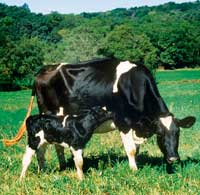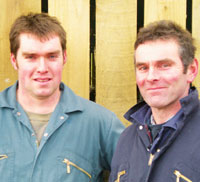Case study – Bovine viral diarrhoea in the dairy herd

Buying in replacements to re-establish the dairy herd at Ham Farm, Coombe St Nicholos, has brought with it issues with disease control, according to Jason Hutchings.
“Three years ago we decided to start a dairy herd again, the thinking being it was a better way of using grass – which we are good at growing – and better at generating a regular income.” The farm, near Chard, had previously been a dairy unit, but Jason’s father, Ivor, had been rearing beef animals in recent years.
“I was working on another unit, milking cows for someone else but was keen to go back home and start milking my own animals,” explains Mr Hutchings.
The Hutchings made a start searching out stock for the new herd, sourcing groups of British Friesian-type animals from local herd dispersals. Within three years they have increased numbers from 23 to 80 cows, with plans to expand to 100 cows in the future.
 |
|---|
| Jason (left) and Ivor Hutchings. |
In 2008, XL Vet practice, Synergy Farm Health did a push on bulk milk screening and Ham Farm was one farm keen to participate.
Making use of subsidised testing schemes such as DairyCheck is a great way for vets to start talking to their clients about infectious diseases and can help establish what losses a herd can be facing, says vet Ed Powell-Jackson. In fact, the project was so successful that all but one of Synergy’s dairy clients took part.
“The Hutchings had been worried there were too many abortions in the Home Farm herd, and also cows were taking too many services to get in calf,” he says.
It was not unexpected, therefore, that DairyCheck results showed the herd was positive for bovine viral diarrhoea (BVD). “We also ran a repeat test to build up an accurate picture of what was going on as antibody levels can indicate whether it is active infection or previous exposure,” explains Mr Powell-Jackson.
Because we had animals in from multiple sources, we were not always sure of their vaccination status, so a whole herd vaccination policy was undertaken in 2008, explains Mr Hutchings.
“From here on in, all adult milkers will receive an annual booster, and anything new coming into the herd will receive a full primary course. We will also try to establish whether or not new animals coming into the herd have been vaccinated previously.”
BVD can commonly cause immunosupression, problems getting cows in calf and abortions, says Mr Powell-Jackson.
“And when we spent time examining the herd’s performance we could see it had been affected by all of these problems. However, now BVD has been controlled and a suspected Persistently Infected animal culled out, calf health has improved as has fertility,” he says.
“This is a cattle dense area and the Hutchings run a flying herd with replacements reared away. Add to this the fact they intend to continue to build the herd to about 100 and it makes sense to continue to control and manage this nasty disease that is capable of causing significant economic losses,” concludes Mr Powell-Jackson.
BVD key facts:
• Clinical signs of BVD include mucosal disease, reduced fertility, increased pregnancy losses and immuno-suppression.
• Immune suppression will make animals susceptible to diseases such as pneumonia and neospora
• BVD virus is spread via nasal secretions and faeces
• When a cow is infected during pregnancy the calf will be born a carrier and will shed virus for the rest of its life – the calf is termed a persistently infected or PI animal.
• PI animals form the primary source of BVD infection
